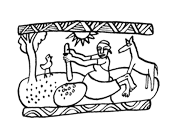|
|
 |
|
|
|
Wood
|
To make floors, boxes, tool handles, boats/canoes, furniture, joinery, tools, yokes, plates/bowls, mortars, stools, beehives, toys, ornaments, drums and curios.
|
Tannins / Resin
|
Red/brown dye and inks from the bark and resin.
|
Fruit Skins
|
Used as a fertiliser in Pearl Millet fields in Namibia
|
Truncheons/plants
|
Live fences
|
Bark
|
- For ritual, religion, magic
- A decoction is taken to remove defilement caused by eating foods in the relatives' house where there has been a death without the performance of necessary purification rites
- Venda people administer powdered bark to expectant mothers to regulate the child's sex
- Zulus and Thongas use a decoction of the bark as a ritual cleansing emetic before marriage
- Zulu healers bathe in a decoction of the bark before treating a patient with gangrenous rectitis
- Newly-born girls and their mothers are washed on a fire heated by marula twigs so that the baby may be endued with fertility, softness, tenderness and early maturity
|
Leaves
|
- Leaf decoctions are taken and inhaled for malaria in Madagascar
- Leaves may be used as dressings for burns and wounds
- Leaves are used as a relish in food
|
Roots
|
- In Zimbabwe, menorrhagia, bilharzias, sore eyes, weakness and heart pain
- In East Africa, roots are used with other species in an alcoholic medicine known as kati
- In Senegal, root bark and leaves are used with other plants for snake bite and other venom
|
Fresh Fruit
|
Eaten whole, particularly by children. Skin and nuts discarded. Also eaten by cattle, goats, game mammals, elephants, etc.
|
Nuts / Kernels / Oils
|
- Compartmentalised kernels can be eaten as they are or ground up to make porridge, condiments, pseudocereals, and see oil, or mixed with other
|
Source: Winners & Losers in Forest Production Commercialisation: ZF0140/R7795 Marula Commercialisation for Sustainable Livelihoods August 2001

|
|
|